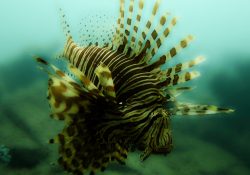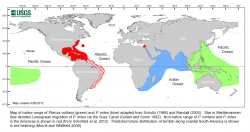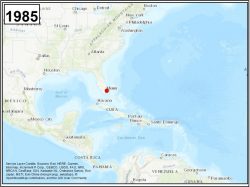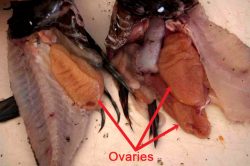Divetalking » Adv. Open Water, Article, Conservation, Divetalking, Earth, Education, Featured, Fish, Lionfish, ocean, Products, Promotions, Reefs, Reference » Invasion of the lionfish – From Reef to Table
Invasion of the lionfish – From Reef to Table
There is a species invading the Eastern United States seaboard, the Gulf of Mexico, Caribbean, Bahamas, Bermuda, Mexico, Central and South America with unprecedented, alarming speed. Armed with venomous spines, a non-discriminating palate, ability to survive in various salinities and depths, high reproductive rate, a gluttonous ambush predator voracious of your food supply.
The invader appears exotic to some, to others an opportunity. This non-indigenous species is commonly referred to as: Lionfish.

Watch this National Geographic video to get a sense of the impact lionfish have on the ecology and environment offshore. Observe at the number of lionfish there are in one area alone.
Lionfish Biology
Lionfish are of the same family as the scorpionfish, Scorpaenidae, the Genus Pterois and species volitans – (Red Lionfish) and miles – (Devil Firefish). The two species of lionfish that have shown up to be invasive, are the Pterois volitans and Pterois miles, (The P is silent).
Where did they come from?
Lionfish are indigenous, that is to say, they are native to the Indo-Pacific region. No one knows for sure how the invasion started since the first reported lionfish off the coastal water of Florida. Theories are they were released by fish collectors, introduced during hurricane decimated areas, arrived in cargo vessel holds. No one knows for sure but we do know they are here and they have been classified as being responsible for one of the largest destructive invasions in history.

Dispersal and Current Range

The natural range of the Pterois-Mile’s firefish (in blue) and Pterois-Volitans red lionfish (in green). The non-native range of these species include the Americas and the Mediterranean (in red).
The Invasion
The lionfish was first reported off the coast of Florida in the mid 80’s. Sporadic reports came in other areas of Florida, Bahamas, Caribbean, the Gulf of Mexico, Mexico. The invasion consists almost entirely of two species, Pterois volitans (red lionfish) and Pterois miles (common lionfish or devil firefish). Virtually indistinguishable from each other outside of the laboratory. P. volitans is made up approximately 92% of the total invasive population. They prey in coral reef ecosystems on invertebrates such as crab, shrimp, lobster, snails and fishes, including juvenile game fish such as snappers and groupers to name a few.
Click on the photo below to be taken to the US Geological Survey animated gif showing the reach of the lionfish.

What have we learned?
Since the first reported sighting in the mid 80’s, up to the current year 2020, the lionfish range and population has grown at an alarming rate.
Lionfish are ambush predators which is to say, they are calculating, approach their target prey with extreme confidence or indifferent to threats, alone or in packs and as if a high powered vacuum was turned on, they suck their prey into their mouth.
Lionfish compete with native animals for food and space. In their new environment, they can multiply and spread at an alarming rate
They can devour prey twice their size and have been found with over 60 prey in their stomachs. Though rare to see lionfish that have reached sizes up to 19+ inches (482+mm) and over 3 pounds (1400+ grams), the average is somewhere in the 12-14 inch and 1.5 – 2 pounds range near or at the age of maturity.
Breeding
Once the lionfish come to maturity and begin breeding, which is about 8 months into their life cycle, the female will release between 10,000 and 30,000 unfertilized eggs every 4-6 days year around. That is approximately 2 MILLION eggs per year. The females releases a pair of egg sacs that are between 1 and 2 inches long when spawning.

It is believed the egg sac contains a chemical deterrent that discourages other fish from eating the eggs. The eggs sacs and larvae are distributed by ocean currents, which have their increase in range since first reported, reaching NE United States down to Brazil South America, and eastward towards Bermuda, Bahamas.
What preys on Lionfish?
Lionfish have no known predators outside of its native habitat, which means the indigenous species have not had enough time to ingrain into their genes, through observation, training, experience the targeting of lionfish as an opportunity. What does this mean? It means there are no known native preditors of the lionfish and the lionfish have an advantage of being an predictor unchecked. They are unchallenged and are free to roam without fear of repercussion.
What is the problem?
Lionfish not having any known natural preditors in the region they have invaded means they go unchecked and consume as much of what ever they can fit in their mouth. They have been found with octopus, crab, shrimp, grouper, snapper, snails, grunts, a variety of reef cleaning species and other lionfish in their stomachs. As much as 60 species of prey have been found in one lionfish stomach alone. They can go for extended periods of time without eating, loosing very little mass.
Mentioned above, the female can release as many as 30,000 eggs every 5-6 days. They can begin reproducing in as little as 7 months. They are gluttonous consumers of prey and they have no known natural predictors.
Imagine if just 10 lionfish survive to maturity out of 30,000, over the course of 1 year that would be 520. Of those 520, if 50% were females and those females starting at 7 months released 30,000 eggs and out of those 10 lionfish survive, you can begin to see how fast the exponential explosion of the lionfish mass becomes. We have accepted this fact and know there is no way at this time to eradicate them. The best we can do is attempt to control their numbers.
This is a recipe for destruction and as time has shown, they certainly hold the title for being responsible for being the most destructive invasive species known in modern times.
Toxic
The body is white or cream colored with alternating bold narrow vertical bands of red, maroon, or red-brown alternating vertical stripes. A common misconception is Lionfish are poisonous. Lionfish are not poisonous. Along with the exotic appearance come venomous spines. 18 of them. 13 may be found along the back (Dorsal), 3 along the anal and 2 along the pelvic spines (One at each of the leading edge) as seen in the depiction below.

Getting stung
The most dangerous part of handling lionfish is getting impaled by one of the barbs containing neurotoxin.




The three images above show two divers envenomed by the toxic spines of a lionfish. You can see the swelling of the divers right hand in the left and center photo. The thumb a week later of another diver.
Someone who has experienced a lionfish barb penetrating the skin and introducing the venom will experience pain immediately at the site. The severity of pain depends on the amount of neurotoxin introduced to the wound area. Swelling usually follows within minutes.
First Aid
The affected area should be immersed in heat that is as hot as the person can bear but not hot enough to scald the area. Hot water, heat packs work well. An analgesic may be administered if requested. Pain relief is usually immediate once heat is applied, slowing or rendering the protein based neurotoxin inert. Allow the affected area to remain on heat for as long as necessary. 30 minutes to and hour should help reduce the pain and swelling.
Are lionfish good to eat?
The meat is safe to eat and perhaps some of the best you may ever taste. Lionfish have higher concentration of heart healthy omega-3 fatty acids and is healthier than eating snapper or grouper as well as tilapia, Bluefin tuna, mahi mahi, wahoo and other table-fish commonly served. Lionfish also contain very low levels of heavy metals like mercury and lead!
You may find nutritional facts on the lionfish here.
You may be one of the lucky ones who have experienced how tasty a fish they are as well. Everyone that has tried lionfish say it has become one of their top favorite fish to consume.
Lionfish meat is tender and slightly firm. Firm enough so you feel it as you bite into it as it gives way to the lightly firm texture. It’s soft clean taste has you wanting more. Lionfish do not have a fishy taste or smell when fresh and may be prepared in many wonderful ways. Like any fish, you fillet and prepare them the same way you would any fish, to include Sashimi. This author favorite way to enjoy lionfish is Ceviche style.






How can you help?
There are a number of ways you can help control the lionfish population. You do not need to be a diver, or a boat captain, wholesaler, retailer or anything like that. All of the aforementioned come together when you make that request for lionfish.
Here is how you can help. When you visit your local grocer, ask the fish department if they have lionfish. If they do not, ask if they can get lionfish.
While out at a restaurant, ask if they serve lionfish. If they do not, ask if they wold consider adding it to their menu.
The point is the more people that request lionfish, the more demand their is. The more demand, the more reason for divers to go and harvest lionfish. Spearing the lionfish through diving is today the only way to harvest quantities enough to support the food industry.
Education is our best defense. Help spread the word. Learn what you can and educate other to the existence and the challenge we are facing. Locate and try lionfish to experience the delicacy of its meat.
There are restaurants and grocery stores what offer lionfish but they are few and far between compared to the number of stores and restaurants there are. If they are ordering grouper, and snapper and other species for sale, they can ask for lionfish to be added to that list.
The problem is, the majority of retail outlets and consumers are unaware of lionfish, have not experienced how wonderful they taste and how healthy they are compared to other fish. I am confident, if you love fish and you try lionfish, they will become your number one fish. It is hands down the best tasting fish you my ever taste.
How much would it cost to buy lionfish?
Lets take a peek behind the scenes. What is involved in harvesting, handling, transporting and preparing lionfish.
First there is the diver. The diver incurs a cost to harvest. Let use four dives and supporting equipment.
Divers Costs
We’ll use $2.50 – $7.00/pound as the Avg. rate. Divers may loose money or make $100’s to over a $1000 for the sale of their lionfish catch, minus their expenses of course. It all depends on the dive site, the quantity and size of the lionfish. The more lionfish and the bigger they are the greater chances of making some money.
Costs
Wholesalers buy the lionfish from the divers. In the above example it was $2.50/lb. Wholesalers manage the catch by using sanctioned handing guidelines set by the governments. For example, must remain on ice, hand off documentation, transportation, containment units, etc. In turn the wholesaler may get $6+/pound from the buyer or processor. By the time it reaches your restaurant or favorite store, the cost per pound could be nearing the mid teens. It is not uncommon to see lionfish sold for over $20/pound but it’s well worth it.
Why is lionfish worth so much?
There are many views for this question. Knowing now that lionfish have no known predictors in their non-native regions, are ambush and non-discriminatory gluttonous and voracious consumers decimating young prey, prey such as your favorite octopus, grouper, snapper, crab, lobster, etc that leaves fewer of those prey to grow to maturity and have offspring of their own. The result is a decrease in native population and this decrease leads to increase prices. Study’s show lionfish can decimate a reef of over 80% of its native population in a very short time.
The next time you buy fish and notice the prices going up, it could be due to the stock of that native species being reduced and has become harder to find.
Want to learn more?
There is a lot of information out on the internet. Consider going first to the websites for organizations that are charged with the collection of data, organizations such as NOAA, USGS, REEF. Contact a local dive shop to see if they have anyone of staff that can answer your questions. Ask if they conduct lionfish seminars and if not, will they.
You may reach out to Divetalking. We are happy to help you to learn more and may be able to assist by sending an email to lionfish@divetalking.com
Are you ready to look at lionfish gear? If you are click here to be taken to Zookeeper, where all the equipment you need to support lionfish harvesting may be found.
© 2020 – 2022, admin. All rights reserved.
Filed under: Adv. Open Water, Article, Conservation, Divetalking, Earth, Education, Featured, Fish, Lionfish, ocean, Products, Promotions, Reefs, Reference








